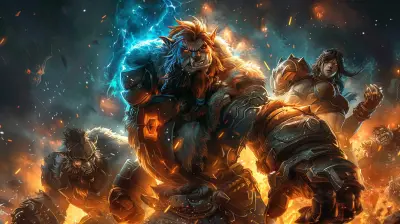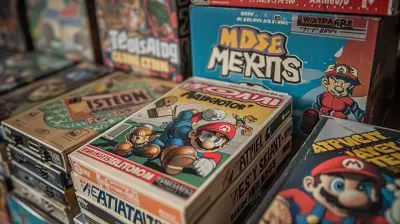How Developers Create Empathy for Pixelated Heroes
31 March 2025
Ever found yourself holding back tears over a character made of nothing but a few dozen pixels? Strange, isn't it? For decades, video game developers have worked magic to make us care deeply about blocky, low-resolution heroes who, at face value, appear more like Lego figures than actual people. There’s something profoundly fascinating about how they achieve this. So, how do developers breathe life into pixelated protagonists and make us feel something real for these virtual avatars?
Let’s peel back the digital curtain and dive into the delicate, thought-provoking art of fostering empathy for pixelated heroes. Because, trust me, there’s a lot more to it than just a catchy storyline or flashy graphics.![]()
The Power of Storytelling: Heartstrings Wrapped in Pixels
At the core of every emotional connection to a video game character lies one thing: storytelling. It’s the bread and butter of creating empathy. Developers use compelling narratives to anchor us emotionally to the character, even if they’re nothing more than a tiny humanoid made of square blocks.Take Celeste. A game about a young woman named Madeline climbing a mountain might sound simple. But the nuanced portrayal of her internal struggles with depression and anxiety creates a powerful emotional resonance. You’re not just watching her story unfold; you’re living it. With every failed jump and every retry, it feels like you’re lifting her burden alongside her. The story isn't just told to you; it’s told with you. And that’s where real emotional connection begins.
Games tap into classic storytelling techniques—overcoming loss, triumphing against adversity, finding redemption. These are universal themes we all connect to. And when you mix a solid story with interactive gameplay, you’re no longer a passive observer. You’re Madeline. You are the hero. That’s the hook.![]()
Visual Simplicity, Emotional Complexity
We often assume high-quality graphics are essential for emotional engagement, but that couldn’t be further from the truth. Pixel art might look basic on the surface, yet this simplicity is its superpower. It allows players to project their own emotions and interpretations onto the character. Funny how our brains fill in gaps, right?Think about Undertale. Its protagonist, Frisk, is essentially a chubby stick figure with a face so simple you’d miss it during a quick glance. Yet, through clever dialogue, nuanced relationships with other characters, and moral choices, Frisk feels more human than some hyper-realistic 3D characters.
Pixel art leaves room for imagination. It’s like reading a book instead of watching a movie—the player's mind does half the work, making the character feel personal. Those tiny, expressive animations? They’re worth more than hours of vocal dialogue. A slight tilt of the head, a wobble when they’re scared—it’s all designed to evoke emotion with minimal resources. ![]()
Music: A Pixel Hero’s Secret Weapon
Music is the unsung hero (pun intended) of building empathy in games. A well-crafted soundtrack doesn’t just complement a game; it whispers directly to your soul. Think back to the melancholy piano keys of To the Moon or the hauntingly beautiful orchestral sounds in Hollow Knight. These tracks aren’t just background noise; they’re emotional cues.Ever play a game where the music swells during a heroic moment? You start feeling it too. That surge of adrenaline or teary-eyed pride is no accident—it’s meticulously planned. Developers and composers know that music has the unique ability to bypass logic and speak to raw emotion.
Even in retro games like Chrono Trigger, with its 16-bit soundtrack, the music triggers nostalgia and deep emotional reactions. That’s the magic of sound—its ability to connect with us on an elemental level, pixelated hero or not.![]()
Player Choice: Agency Breeds Empathy
Here’s a question: why do we care about game characters even though we know they’re not real? One word—agency. Developers make us the decision-makers. And when you have a hand in shaping a character’s story, you feel responsible for their fate. That’s empathy in action.Take The Walking Dead by Telltale Games. You’re not just following a script; you’re making gut-wrenching choices that impact Clementine and her group. Save a life or let them perish? Betray someone or keep a secret? These choices anchor you emotionally because they’re your choices. The fallout isn’t just happening to the character—it’s happening to you. That shared experience builds a bond.
It’s no wonder moral choice systems are so effective. They turn a simple sprite into someone you care about. Because, let’s face it—when you’ve fought tooth and nail to keep a companion alive (even if they’re nothing but pixels), they stop being “just a character.”
Relatable Flaws: Perfect is Boring
Nobody loves a flawless character. That’s not how the world works, and that’s not how we connect to people—fictional or otherwise. Developers know this, which is why pixel heroes are often deeply flawed.In Shovel Knight, the protagonist isn’t just a shovel-wielding warrior. He’s driven by loss and guilt over his fallen partner, Shield Knight. That vulnerability makes him relatable. Similarly, in Hollow Knight, the narrative touches on themes of solitude and existential questioning. These aren’t just mindless heroes out for revenge; they’re layered, imperfect, and deeply human. And, honestly, who doesn’t relate to being a little broken sometimes?
By giving characters relatable struggles—be it love, loss, or existential dread—developers make pixelated heroes feel like they resonate with our own messy, complicated lives.
The Role of NPCs: Relationships Matter
No hero exists in a vacuum. Well, unless you’re in space. But even then, their relationships with Non-Playable Characters (NPCs) add depth and dimension to their journey. NPCs can act as emotional anchors, providing context and relatability for the hero’s actions.In Earthbound, much of the protagonist Ness’s charm comes from the quirky and heartfelt relationships he builds throughout his journey. His ragtag group of friends, his loving (but slightly weird) family, even the odd-ball NPCs—they create a vibrant, interconnected world that makes Ness feel real.
Relationships build stakes. If you’ve ever played The Legend of Zelda: A Link to the Past, you know the heartbreak of seeing your uncle fall in the dungeon. These interactions give pixelated heroes something worth fighting for, something to lose—and that’s what makes us care.
Why Humor and Whimsy Matter
Empathy doesn’t always stem from serious, soul-crushing narratives. Sometimes, it’s the little moments of humor that make you fall in love with a hero. A goofy aside, a silly dance, or that time you accidentally made your character trip—it’s these snippets of humanity that make them feel alive.Games like Stardew Valley or Undertale are brimming with whimsical moments that make you smile or laugh in between heavier emotional beats. Humor is disarming—it allows us to connect with a character on a lighter, more personal level. It’s like hanging out with a friend who makes you laugh even when things are rough.
The Evolution of Immersion
If there’s one thing modern developers have mastered, it’s immersion. They don’t just drop you into a game—they suck you into a whole universe. With advances in mechanics and storytelling, games now encourage us to live in the hero’s shoes, not just occasionally wear them.Consider games like Hyper Light Drifter. The protagonist never speaks, yet their story of illness and survival becomes yours. Through creative gameplay design, environmental storytelling, and intuitive controls, developers immerse you so deeply that empathy becomes almost inevitable.
Immersion isn’t about the biggest graphics or the most lines of dialogue—it’s about letting the player feel. And once you feel, you start caring.
Why Empathy Matters for Gaming
So why go through all the trouble? Why should developers even bother making us feel for these pixelated heroes? Well, empathy is what elevates gaming from a mere pastime to a profound experience.Empathy bridges the gap between player and character. It’s what makes video games an art form that can stand shoulder-to-shoulder with books and films. Whether it’s a retro adventure or a modern indie game, the connection you feel to a pixelated hero stays with you long after the credits roll. That’s not just good game design—it’s storytelling at its finest.
Conclusion
Making players care about pixelated heroes isn’t some accidental afterthought. It’s a finely tuned combination of storytelling, music, simplicity, player agency, and emotional nuance. Good developers don’t just create games—they craft experiences that linger in the heart. The next time you find yourself tearing up over a pixelated farewell, remember: every element, from the story to the soundtrack, was designed to make you feel.Because, in the end, pixelated or not, heroes are heroes. And when you care about them, they’re as real as anything can be.
all images in this post were generated using AI tools
Category:
Video Game CharactersAuthor:

Brianna Reyes
Discussion
rate this article
5 comments
Zylith Rios
In pixels, hearts entwine; through crafted tales, we find our own reflections shine.
April 10, 2025 at 3:26 AM

Brianna Reyes
Thank you! I'm glad you resonated with the idea of finding ourselves in these pixelated stories. It’s fascinating how games can forge connections through shared experiences.
Zethryn McDowell
“Who knew pixels could tug at our heartstrings? Pass the tissues, please!”
April 7, 2025 at 4:35 PM

Brianna Reyes
Thank you! It’s amazing how a few pixels can evoke such strong emotions. Glad you felt it!
Michelle Reese
Great insights on character connection!
April 6, 2025 at 3:34 AM

Brianna Reyes
Thank you! I'm glad you found the insights valuable!
Bella Evans
Fascinating topic! It’s incredible how developers can craft deep emotional connections with pixelated characters. I’m curious about the techniques they use, like storytelling and design choices. How do they balance gameplay mechanics with emotional depth? I'd love to hear more about specific examples that really resonate with players!
April 5, 2025 at 4:32 PM

Brianna Reyes
Thank you for your interest! Developers often use immersive storytelling, relatable character arcs, and visual design to evoke empathy. Balancing gameplay and emotional depth involves integrating mechanics that reinforce narrative themes, as seen in games like "Celeste," where challenges reflect the protagonist's struggles. I'll delve deeper into these techniques in the article!
Owyn Reilly
Love this insight into game design!
March 31, 2025 at 2:52 PM

Brianna Reyes
Thank you! I'm glad you found it insightful!




